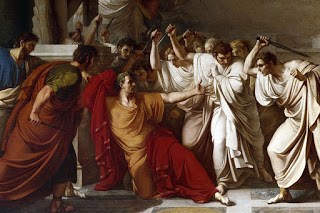

| Online: | |
| Visits: | |
| Stories: |
6 Implied Threats of the Ides of March
6 IMPLIED THREATS OF THE IDES OF MARCH
In recent days there have been several hints/threats implied by anonymous writers on the internet to be concerned about ‘the Ides of March’, March 15th, and what it may mean for our nation.
These anonymous implied threats may indicate a copy cat scenario of the story of Julius Caesar and/or for our nation.
Please pray for the protection of our President and his family and staff more than ever during this time.
This is what most of us know about the death of Julius Caesar, half-remembered from movies and plays:
- Some soothsayer said, “Beware the Ides of March.”
- A few idealistic Romans decided to win back Rome for the people.
- Caesar got stabbed by Brutus with a big sword, said “Et tu, Brute?” and died nobly.
All of that is wrong.
In major and minor ways, a lot of us misunderstand the death of Julius Caesar on March 15, 44 BC. That’s why I talked to Barry Strauss, a Cornell classics and history professor. He’s the author of The Death of Caesar, a new book that chronicles one of history’s most infamous assassinations and dispels a lot of half-remembered myths.
A lot of those myths come from Shakespeare who relied exclusively on Plutarch to paint his picture of Rome. But Strauss uses Plutarch in concert with other ancient sources like Nicolaus of Damascus, Suetonius, Appian, and Cassius Dio, as well as the work of other scholars. Weighed against one another, together they form a more complete picture of Rome at the time — and one that happens to bust a lot of myths.
Myth 1: A soothsayer told Caesar, “Beware the Ides of March”
The Ides of March comes from the ides, a term the Romans used to note the middle of a month. Every month has an ides around the middle (as well as a calends at the beginning of the month and nones eight days before the ides). The Ides of March feels special for a couple of reasons: it’s the day Caesar was murdered, and it’s the subject of a soothsayer’s spooky prophecy in William Shakespeare’s Julius Caesar.
The truth is actually more interesting.
For one, we know who the soothsayer was and what he really said: he was named Spurinna, and he was from Etruria. That’s important, because Etruscans were known to specialize in divination. Cicero’s letters , Plutarch, and Suetonius all confirm his high status. As notably, Spurinna’s warning to Caesar was more complex — and more accurate — than the type of prophecy most modern skeptics would dismiss.
“They have a lot of contacts,” Strauss says, “and they’re people who know what’s going on.” That would have made Spurinna’s prophecy a more frightening bellwether of the anti-Caesar sentiment in Rome. Soothsayers could poll the elites, and the elites did not like Caesar.
On February 15, Spurinna said he found a bad omen: a bull without a heart (it’s unclear if the bull was a genetic abnormality, a shocking sign, or a soothsayer’s poetic license). After that, Spurinna told Caesar to beware for the next 30 days, not just on the Ides of March. It wasn’t a lucky prediction but rather a calculated assessment of Rome’s political climate.
The end date of the prophecy wasn’t a coincidence, either — on March 18, Caesar was going to embark on a multiyear military campaign that would take him away from Rome. The assassins had to kill him before he left.
Myth 2: All the conspirators were idealists who wanted to restore Rome to the people There was idealism involved: Caesar was turning the Roman republic into a dictatorship and making himself a king. But there were also deeply personal motives.Self-Interest drove the conspirators to kill caesar
“I think politicians don’t have a firewall between ideals and practical benefits,” Strauss says. “They think what’s good for the country is also good for themselves. The senators who joined the conspiracy against Caesar can sincerely say he was a threat to the republic and to them and their way of life.”
Before Caesar, Roman nobility and military were free to plunder the provinces they ruled. But under Caesar, Rome controlled the process and sent inspectors to check up on everything, so they could only exploit their provinces under Caesar’s supervision.
That slight was compounded by Caesar’s rebranding of political real estate in his name — he built statues in his image and renamed monuments for himself. He brought power to his family by giving them political appointments and honorifics, and drew allies outside the charmed circle of Roman nobility, like his soldiers and leaders in the provinces.
“People in the old nobility feel cut out,” Strauss says. In addition to concern for the average Roman, self-interest drove the conspirators to kill Caesar.
There weren’t just political and financial grudges, either. Brutus’ mother, Servilia, had once had an affair with Caesar, and there were even rumors that Brutus was Caesar’s son (for the record, Strauss thinks that’s highly unlikely). Servilia was also co-conspirator Cassius’ mother-in-law.
Myth 3: Brutus was the assassins’ ringleader and Caesar’s best buddy
As far as epic betrayals go, we tend to imagine Brutus in the same league as Judas. In reality, that infamy should be reserved for someone called Decimus.
Caesar trusted Decimus much more than he trusted Brutus — and that made his betrayal more shocking. Misspelled in Shakespeare’s Julius Caesar as “Decius,” Decimus was much more important than most of us realize. “There were three leaders of the assassins’ conspiracy,” Strauss says. “Brutus, Cassius, and Decimus.”
Shakespeare made Decimus a minor character because he mostly used Plutarch as a source, who gave Decimus short shrift. But all the other ancient sources think Decimus was key, and, according to Strauss, “he’s the only assassin that could really be called close to Caesar.”
Decimus dined with Caesar the night before his assassination and convinced Caesar to leave his house the next morning (he was staying home because his wife, Calpurnia, was worried). Decimus’ betrayal followed an adult life spent at Caesar’s side. Brutus, however, had often fought against Caesar, like when he took Pompey’s side against Caesar in the Civil War that lasted from 49 to 45 BC. He only came over to Caesar’s side after a handsome cash award and profitable political appointment.
Myth 4: Caesar was killed with swords in a grand Senate room
Thanks to epic paintings like Jean-Léon Gérôme’s The Death of Caesar, we imagine a grand scene for a grand death. But the painting gets some things seriously wrong.
In reality, the assassination happened in the Portico of Pompey, a Senate house with a statue of Pompey (Caesar’s enemy) inside. “It would have been a nicely decorated room,” Strauss says, “it’s just not cavernous.” Imagine the British House of Commons instead of the grand room in Gérôme’s painting.
And the assassins almost certainly didn’t have giant swords — after all, it was a surprise attack. They probably snuck in daggers to kill Caesar.
Myth 5: Caesar got stabbed and died nobly, saying “Et tu, Brute”
This might be the most powerful myth of all. And it shortchanges Caesar. This wasn’t a noble death — it was probably a scrappy fight for his life.“et tu, brute” is a renaissance invention
“Caesar is a soldier,” Strauss says. “If you stab this guy, he’s going to try to fight back.”
He may have stabbed one of the attackers with a stylus, and most of the sources say he tried to get up and escape. Unfortunately for Caesar, the conspirators were trained soldiers, so they’d formed a tight perimeter. “They know how you carry out an ambush,” Strauss says. “I believe some of the senators were assigned the job of crowd control.”
As far as what Caesar said when he died, “Et tu, Brute” is a Renaissance invention. But Caesar did perform a few resonant gestures. He tried to escape, like any soldier would, but when death was near, he covered his face before he died. It may have been an attempt to preserve his dignity.
Myth 6: The assassins failed to win the hearts of the Roman people
Without getting into the politics of the Second Triumvirate and imperial rule that followed Caesar’s death, the assassins ultimately failed to restore a meaningful republic to Rome. But it’s not because they failed to win over the people — they failed to win over the soldiers.
The assassins had prepared for the military consequences of the assassination — they had gladiators stationed nearby to help protect them after the fallout from the murder. Led by Decimus, they even stationed gladiators outside the Senate House to protect themselves. But the conspirators miscalculated the political fallout of the assassination.
In his will, Caesar had the ancient equivalent of a poison pill — a massive payout to Roman citizens and soldiers, which fractured support for the conspirators. The Roman republic had been in trouble for nearly a century, ripped apart by civil wars and ruled by armies. Caesar used cash to consolidate power even after death.
“Rome is a military city,” Strauss says. “On the outskirts of the city, Caesar has a legion … and at various places around the city, Caesar’s veterans have gathered to begin a three-year war against the Persian empire at the east. Some are there to show their support, but others are there because Caesar is there to lead them to new lands.”
Those soldiers wanted a significant payout from whoever was going to rule Rome, and Brutus and Cassius didn’t pull it off in time to secure support. That led Rome to eventually fall back in the hands of emperor Octavian (later called Augustus) instead of reverting to a republic.
In a way, that may be the biggest myth about the Ides of March and the assassination of Caesar. Yes, Caesar was killed. But his influence lived on — through him and through the Caesarism that prospered for centuries after his death.
http://www.vox.com/2015/3/15/8214921/ides-of-march-caesar-assassination
NESARA- Restore America – Galactic News
Source: http://nesaranews.blogspot.com/2017/03/6-implied-threats-of-ides-of-march.html






